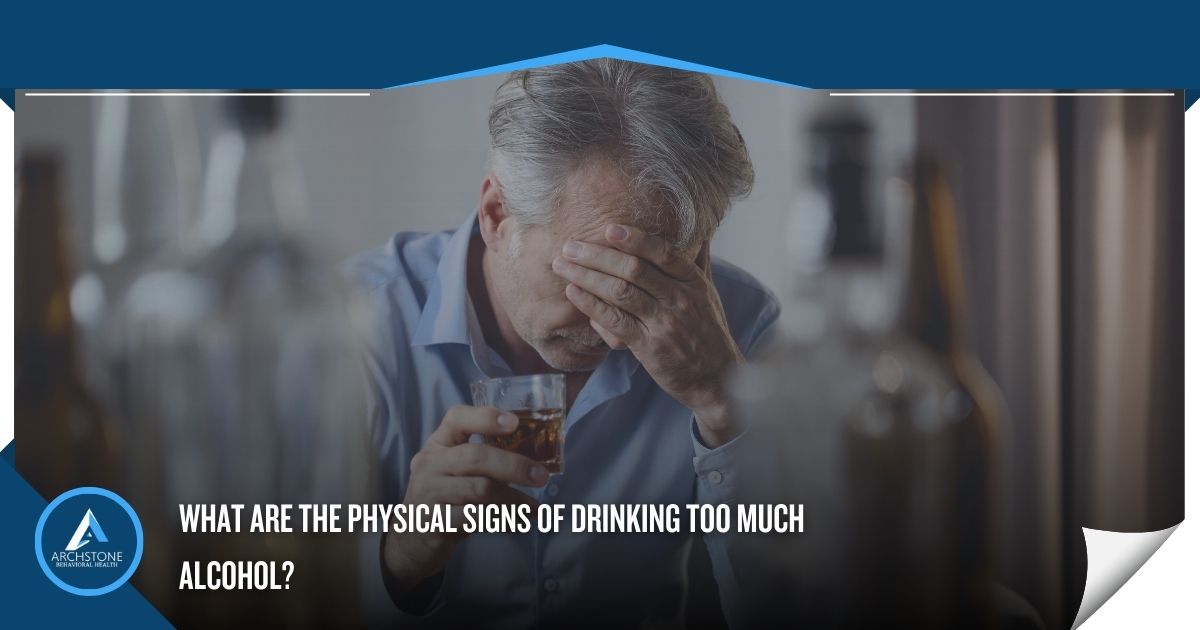What are the Physical Signs of Drinking Too Much Alcohol?
Get Help Now
Alcohol use is common in the United States. Research shows that most adults consume alcohol at least occasionally, and alcohol is widely available in many situations.
Because alcohol use is so common, it can be challenging to tell when your drinking has crossed the line into a harmful habit. However, it’s important to be realistic about your drinking and pay attention to signs that you are drinking too much.
Drinking too much can change the way you look, think, feel, and behave. Watching for these signs can help you identify unhealthy drinking patterns and get treatment.
This article will explore some of the physical signs that your alcohol consumption is unhealthy. You’ll also learn what the CDC recommends, how to identify excessive drinking, and where to find treatment.
Reach out to the Archstone Behavioral Health specialists now to learn about our alcohol abuse treatment programs. You may also verify your insurance, ask questions, or set up an intake evaluation.
Alcohol: How Much is Too Much?
The Centers for Disease Control and Prevention (CDC) advises people to drink in moderation or to abstain from alcohol. But what does “moderate drinking” mean?
According to the CDC, moderate drinking means:
- One or fewer alcoholic drinks per day for women
- Two or fewer alcoholic drinks per day for men
A “drink” doesn’t mean any alcoholic beverage. It is a standard measurement of alcohol. A “drink” means:
- 12 ounces of beer
- 5 ounces of wine
- 1.5 ounces of distilled spirits
- 8 ounces of malt liquor
The CDC defines heavy drinking as:
- Consuming eight or more alcoholic drinks per week for women
- Consuming 15 or more alcoholic drinks per week for men
Heavy drinking increases your risk of developing alcohol addiction. Health experts also believe that regularly consuming too much alcohol can increase your risk for liver disease, cardiovascular problems, mental health disorders, and certain types of cancers.
Binge drinking is another problematic pattern of drinking. During a binge, a person consumes a lot of alcohol (usually five or more drinks) on a single occasion. Binge drinking does not always lead to an alcohol use disorder, but it can increase your risk of immediate and long-term harm.
Physical Signs of Drinking Too Much
Moderate drinking isn’t associated with long-term risks. However, some people might have poor sleep, headaches, and other mild symptoms after drinking any amount of alcohol-even in moderation.
However, regularly drinking too much can cause noticeable symptoms. Heavy drinking prevents your body from absorbing essential nutrients and proteins. This can affect your body’s health and functioning.
Some of the most common physical signs of excessive alcohol consumption include:
- Premature skin aging
- Brittle nails
- Broken capillaries on the face or other parts of the body
- Weight gain
- Bloating
- Thinning hair
- Dull, dry skin
- Dental problems
- High blood pressure
- Bad breath
- Yellowish eyes and skin from liver disease
People who drink too much may also get sick more often. Health experts believe that drinking any amount of alcohol can damage the immune system. Heavy drinking can keep the immune system from working like it should.
Generally, regularly drinking too much alcohol affects people’s ability to care for themselves. People who drink a lot may not exercise, eat well, sleep regularly, or manage their personal hygiene. This can affect their overall well-being and appearance.
Do I Need Treatment For Alcohol Abuse or Addiction?
Many people drink alcohol occasionally, and some drink regularly. Alcohol is widely available in many social situations, and most adults drink.
Because so many people accept drinking as part of everyday life, it can be challenging to figure out when your drinking has become a problem. You can use the CDC’s guidelines about moderate drinking to help you check your alcohol consumption.
It’s also a good idea to be aware of the signs of an alcohol use disorder. These include:
- Needing to drink more to get “buzzed” over time
- Experiencing alcohol withdrawal symptoms (shaking, sweating, anxiety, nausea, insomnia, etc.) if you stop drinking
- Doing dangerous things while drinking, such as driving while intoxicated or having risky sex
- Having legal or financial trouble related to your drinking
- Neglecting your hobbies, relationships, or responsibilities because of your drinking
- Using alcohol to cope with anxiety, sadness, or other uncomfortable emotions
- Hiding or lying about your drinking
- Wanting to stop or cut back on drinking but finding that it’s impossible
- Continuing to drink even though it’s harming your health, relationships, or other parts of your life
Heavy drinking can change the way your body and brain work. These changes can make it very difficult to stop drinking on your own.
Find Help for Alcohol Abuse and Addiction
If you or someone you love struggles with problematic drinking, you are not alone. Reach out to the caring specialists at Archstone Behavioral Health now to learn about our alcohol use disorder treatment programs.
